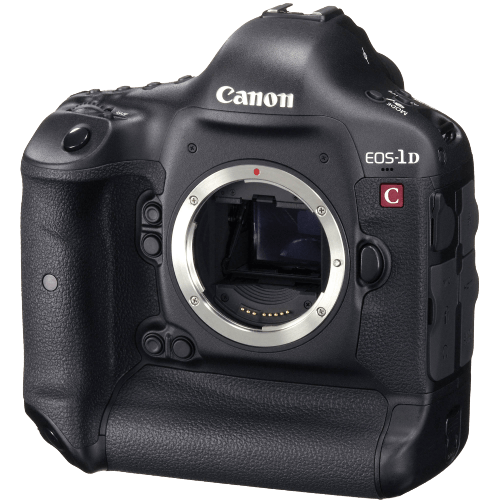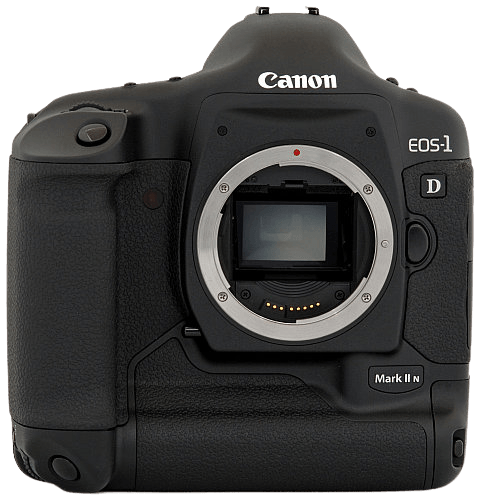Canon 1D C vs EOS 1D Mark II N Comparison
Canon 1D C

Canon EOS 1D Mark II N

The Canon 1D C outperforms the Canon EOS 1D Mark II N with a score of 60/100 compared to 40/100. Both cameras are DSLR types and share similar dimensions, with the 1D C measuring 158 x 164 x 83mm and the Mark II N at 156 x 158 x 80mm. They also have comparable weights, with the 1D C weighing 1545g and the Mark II N at 1565g.
The 1D C’s advantage lies in its more recent release year of 2012, compared to the Mark II N’s 2005 release. This makes the 1D C a more advanced camera with improved features. However, the Mark II N has the benefit of a significantly lower launch price of $5986, compared to the 1D C’s $15000.
Taking these factors into account, the Canon 1D C is the superior camera due to its higher score and more advanced features, while the Canon EOS 1D Mark II N could be a more budget-friendly option for those seeking a capable DSLR camera.
Canon 1D C vs EOS 1D Mark II N Overview and Optics
The Canon 1D C triumphs over the Canon EOS 1D Mark II N in optics, with a score of 56/100 compared to 46/100. Both cameras share common specifications, such as CMOS sensor type, Canon EF lens mount, and lack of image stabilization. However, the Canon 1D C outperforms the Canon EOS 1D Mark II N in several aspects, making it the superior camera in terms of optics.
The Canon 1D C possesses a higher megapixel count at 18, compared to the Canon EOS 1D Mark II N’s 8.2. This results in sharper, higher resolution images. Additionally, the Canon 1D C has a faster shooting speed of 14 frames per second, while the Canon EOS 1D Mark II N lags behind with 8.5 frames per second. This makes the Canon 1D C more suitable for capturing fast-moving subjects or action shots.
Furthermore, the Canon 1D C has a more advanced processor, the Dual Digic 5+, compared to the Canon EOS 1D Mark II N’s Digic II processor. This allows for better image processing and improved performance. The Canon 1D C also boasts a higher DXOMARK sensor score of 81, compared to the Canon EOS 1D Mark II N’s 66, indicating better image quality. Lastly, the Canon 1D C has a full-frame sensor size, while the Canon EOS 1D Mark II N has an APS-H sensor size, which contributes to the Canon 1D C’s superior image quality.
The Canon EOS 1D Mark II N does not surpass the Canon 1D C in any specific area of optics. The Canon 1D C’s higher score reflects its overall better performance in terms of optics. Therefore, the Canon 1D C is the recommended choice for those seeking a camera with superior optical capabilities.
Canon 1D C vs EOS 1D Mark II N Video Performance
When comparing the video capabilities of the Canon 1D C and the Canon EOS 1D Mark II N, it is important to note that the Canon EOS 1D Mark II N does not have any video functionality. As a result, this comparison focuses solely on the video features of the Canon 1D C.
The Canon 1D C has a video score of 83 out of 100. This camera offers a maximum video resolution of 4K, with dimensions of 4096 x 2160 pixels. Additionally, the Canon 1D C supports a maximum video frame rate of 60fps, ensuring smooth and high-quality video capture. Furthermore, this camera includes built-in time-lapse functionality, providing users with the ability to create captivating time-lapse videos with ease.
Given the lack of video functionality in the Canon EOS 1D Mark II N, the Canon 1D C stands out as the superior choice for those seeking a camera with advanced video capabilities. With its high video score, 4K resolution, and additional features such as time-lapse, the Canon 1D C provides users with a versatile and high-performance option for capturing professional-quality videos.
Canon 1D C vs EOS 1D Mark II N Features and Benefits
The Canon 1D C outperforms the Canon EOS 1D Mark II N in features with a score of 72/100 compared to the latter’s 17/100. Both cameras share some common specifications, such as the lack of a touchscreen and flip screen. However, the Canon 1D C surpasses the EOS 1D Mark II N in several aspects.
The Canon 1D C has a larger screen size at 3.2 inches, whereas the EOS 1D Mark II N has a smaller 2.5-inch screen. Moreover, the 1D C’s screen resolution is significantly higher at 1,040,000 dots, providing a clearer and sharper image display compared to the 230,000 dots of the EOS 1D Mark II N. This difference in screen size and resolution makes the 1D C more user-friendly and efficient for photographers.
Furthermore, the Canon 1D C includes GPS and Bluetooth capabilities, which are absent in the EOS 1D Mark II N. The presence of GPS allows for easy geotagging of images, while Bluetooth enables seamless connectivity with other devices. These additional features make the 1D C more versatile and convenient for photographers.
On the other hand, the Canon EOS 1D Mark II N does not have any notable advantages over the Canon 1D C in terms of features. Its lower score reflects its inferior specifications compared to the 1D C.
Taking these factors into account, it is evident that the Canon 1D C is a superior camera in terms of features compared to the Canon EOS 1D Mark II N. The 1D C offers a better user experience with its larger and higher-resolution screen, as well as its GPS and Bluetooth capabilities. In contrast, the EOS 1D Mark II N falls short in these aspects, making it a less attractive option for photographers.
Canon 1D C vs EOS 1D Mark II N Storage and Battery
The Canon EOS 1D Mark II N outperforms the Canon 1D C in storage and battery with a score of 79/100, compared to the 1D C’s 45/100. Both cameras share common specifications, such as not having USB charging capability and accepting Compact Flash (Type I or II) memory cards.
The 1D Mark II N surpasses the 1D C with its dual memory card slots, allowing for SD and Compact Flash cards, and a longer battery life of 1200 shots. Its NP-E3 battery type contributes to this advantage.
Although the 1D C falls behind in this comparison, it still offers a decent battery life of 1120 shots with its Lithium-Ion LP-E4N battery. However, it only provides a single memory card slot, limiting storage options to Compact Flash cards.
Considering these factors, the Canon EOS 1D Mark II N proves to be a better choice for photographers in terms of storage and battery life, while the Canon 1D C remains a viable option with its respectable battery life and storage capabilities.
Alternatives to the Canon 1D C and EOS 1D Mark II N
Are you still undecided about which camera is right for you? Have a look at these popular comparisons that feature the Canon 1D C or the Canon EOS 1D Mark II N:

